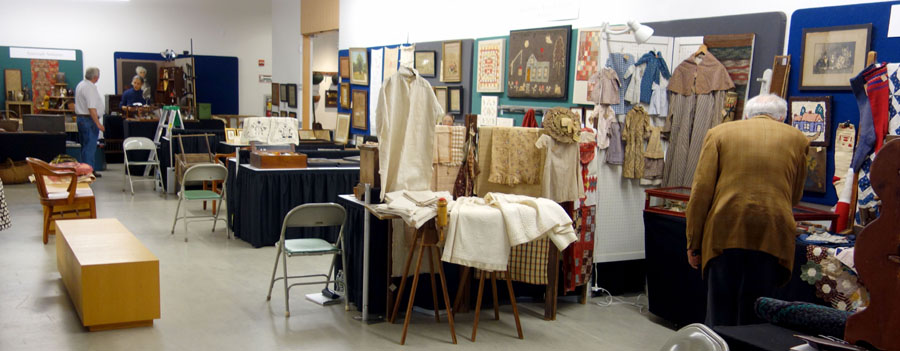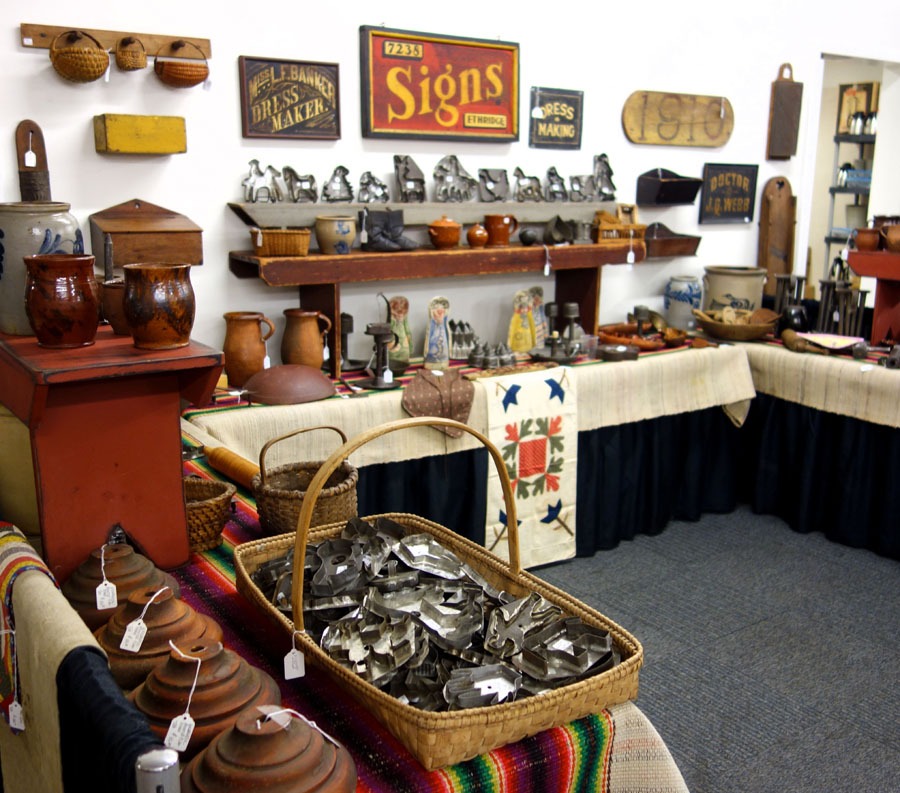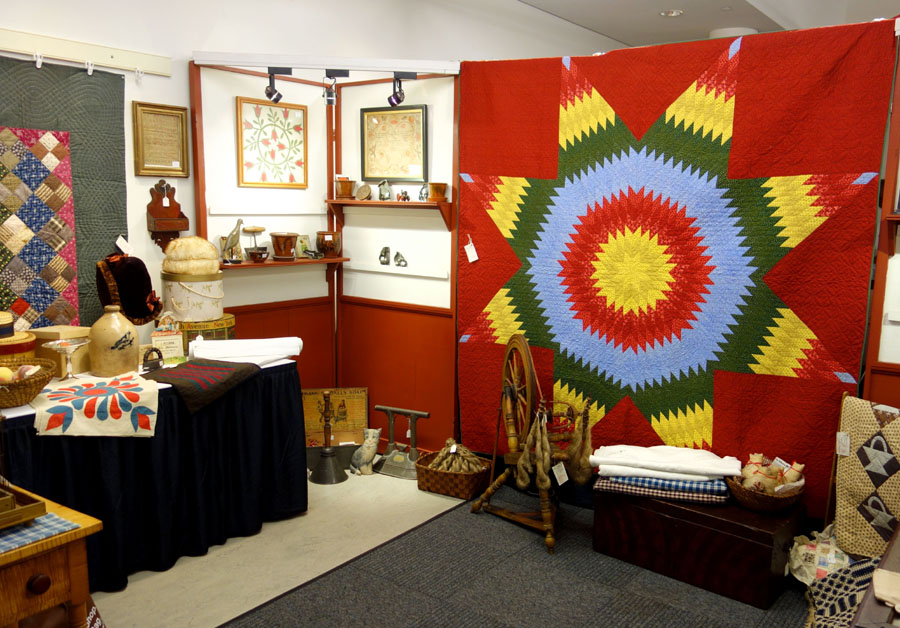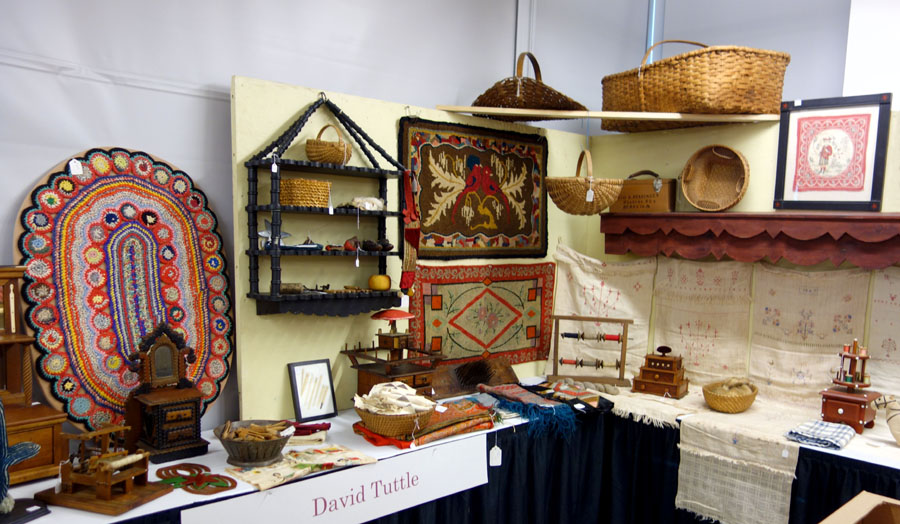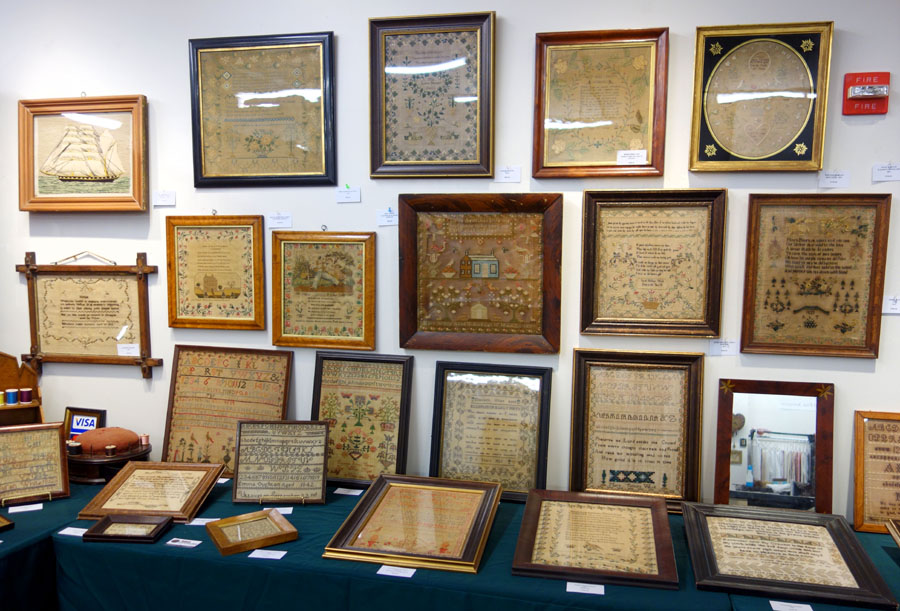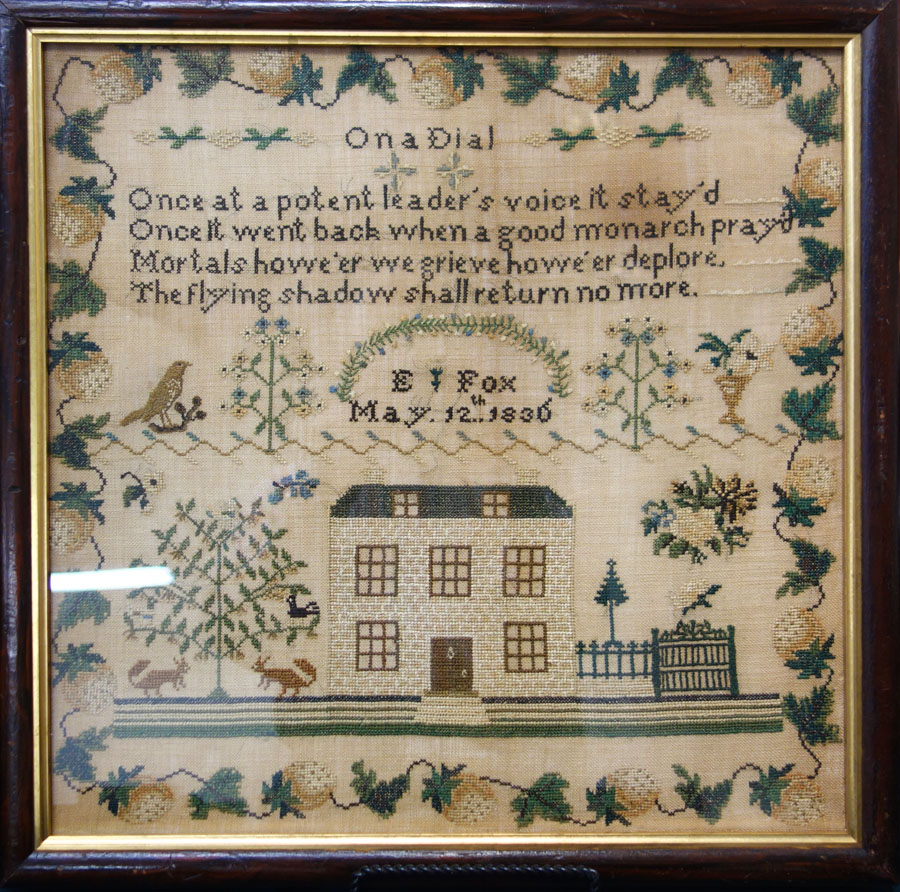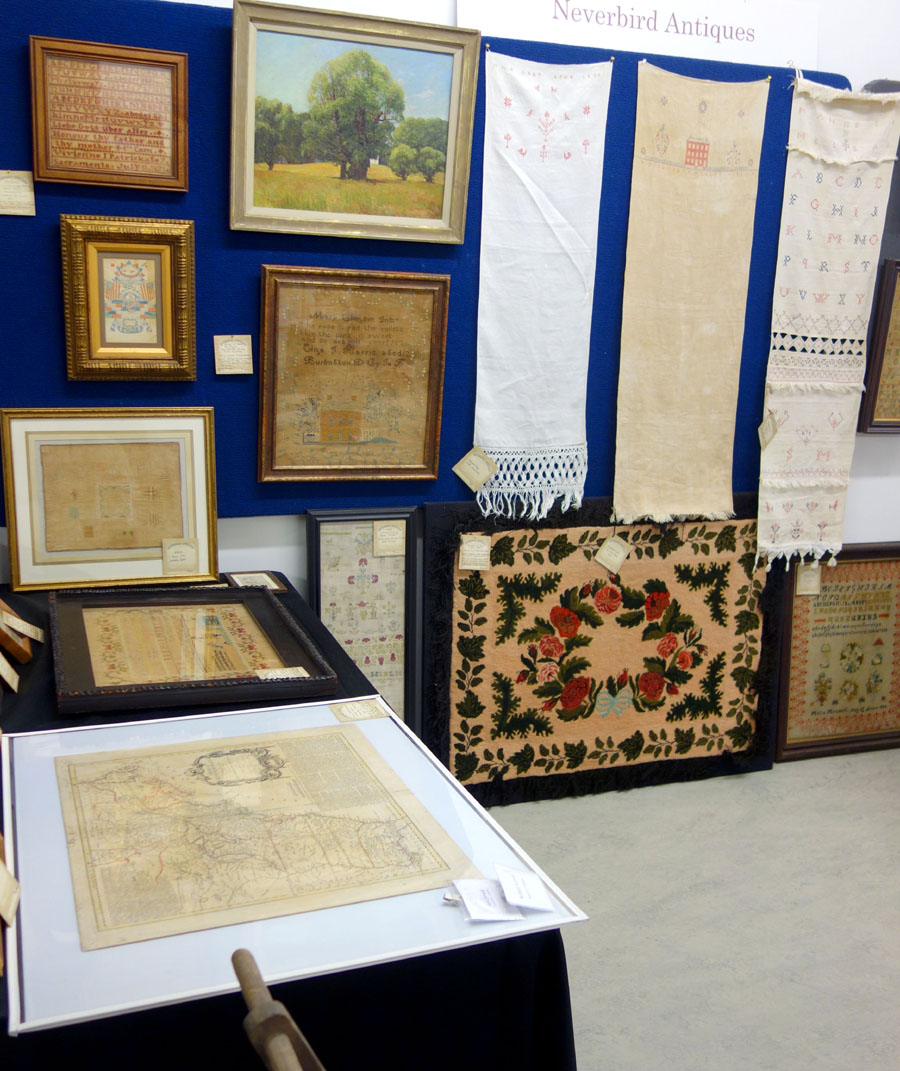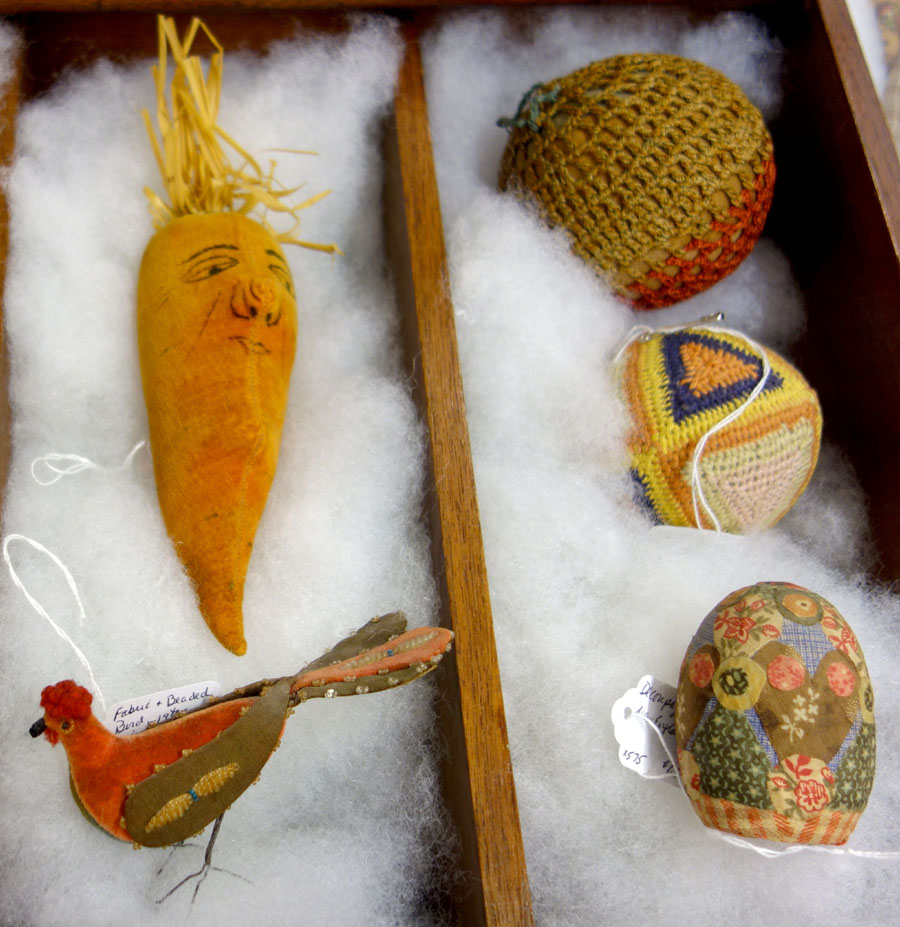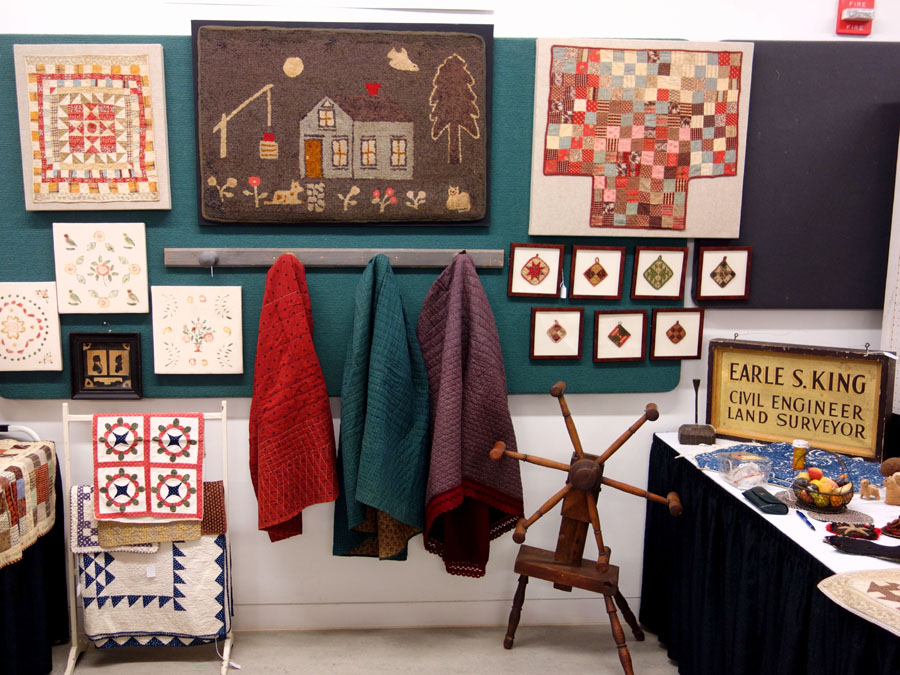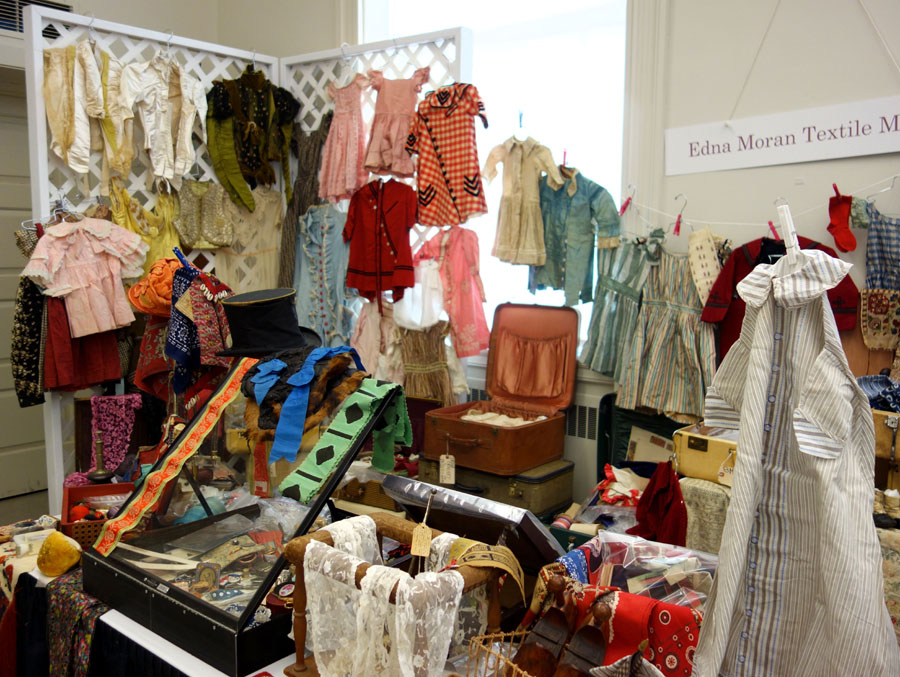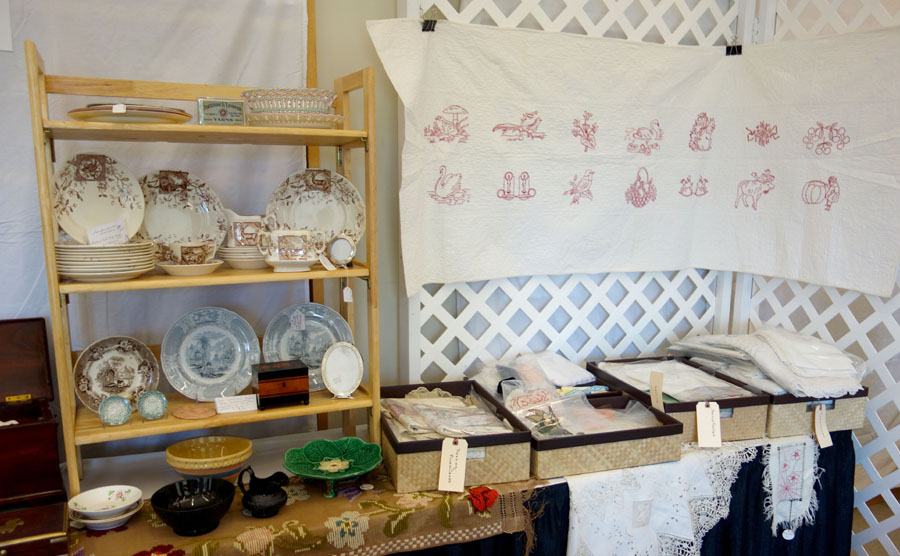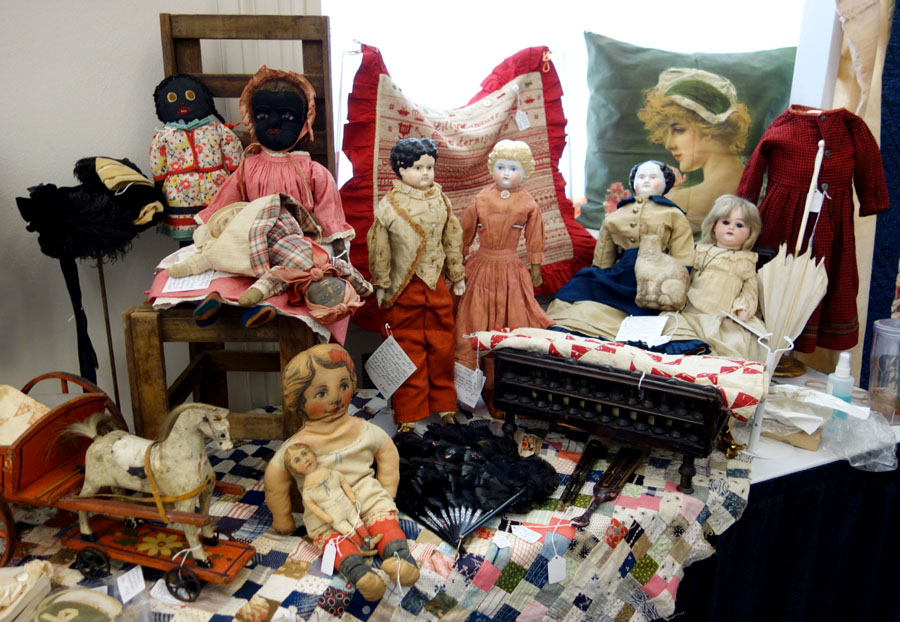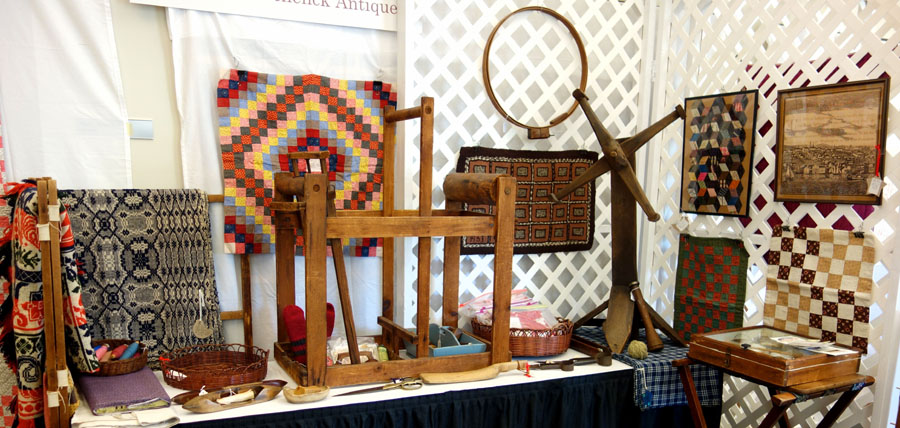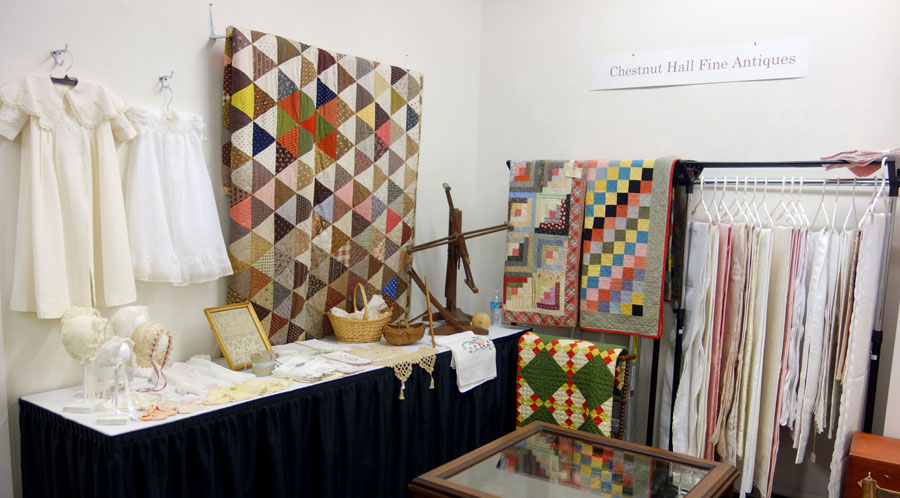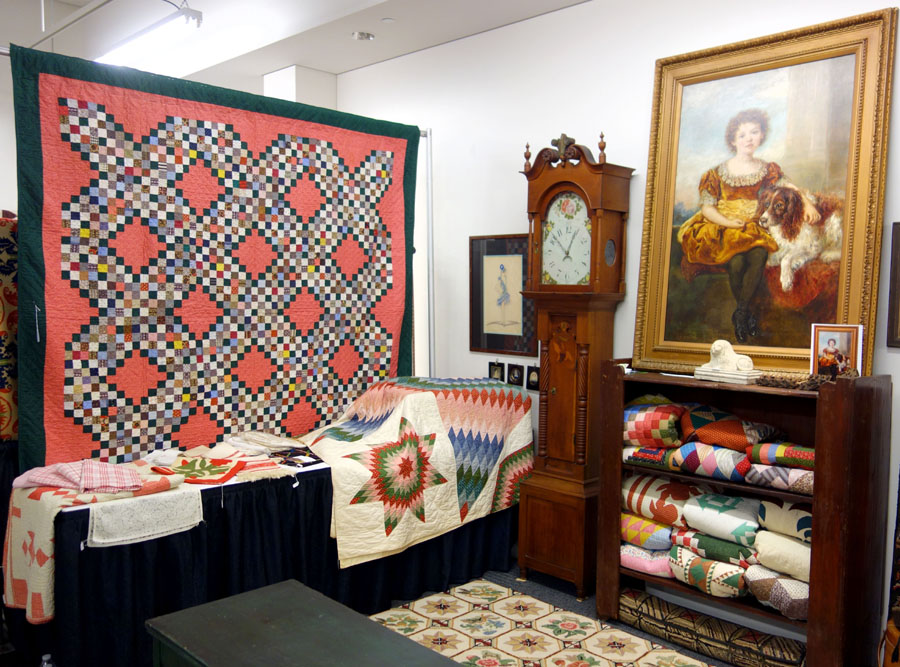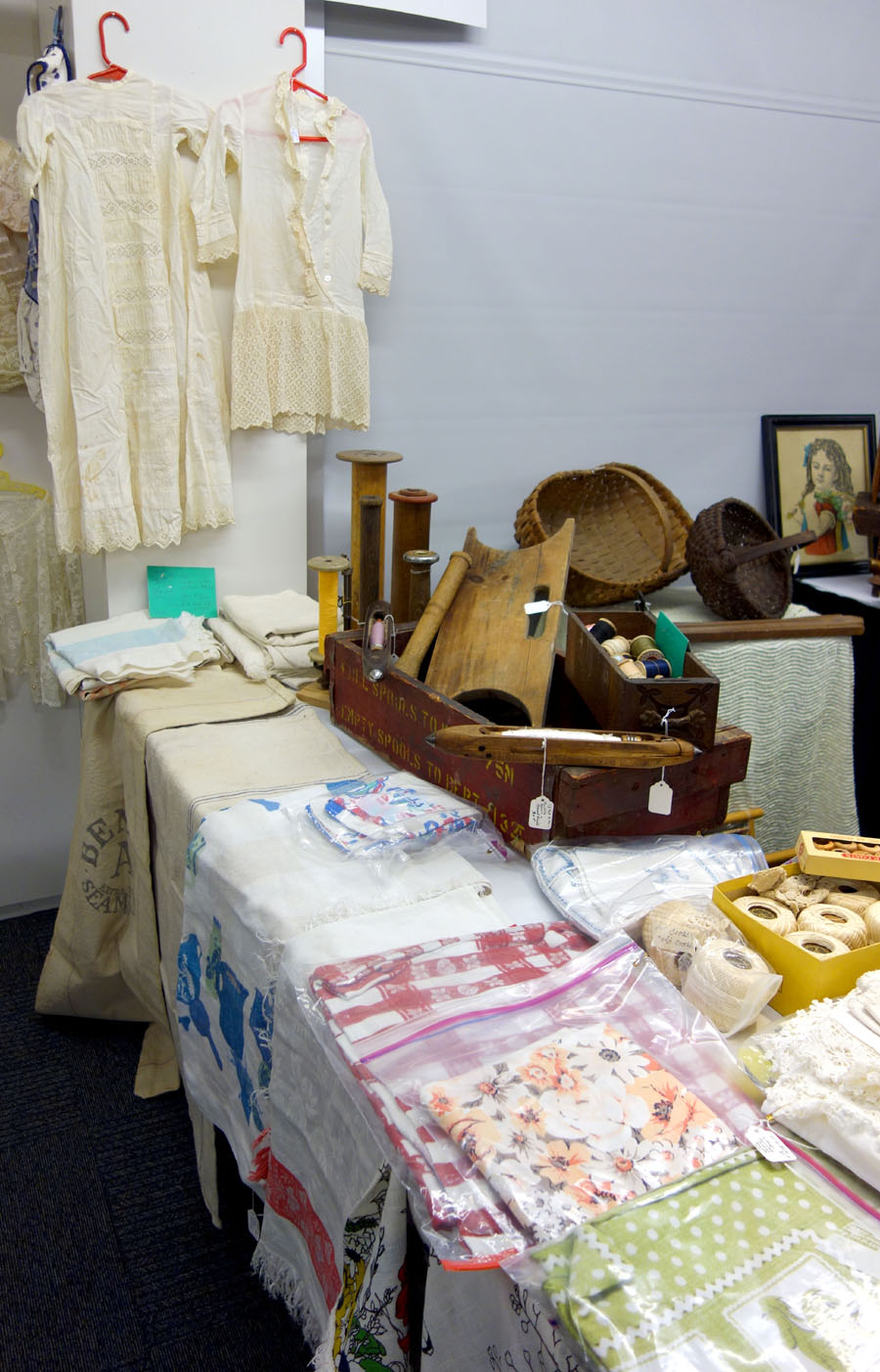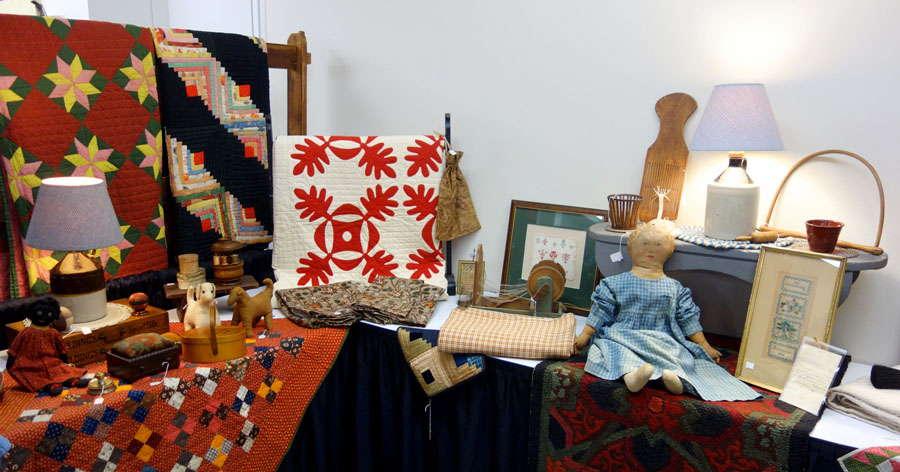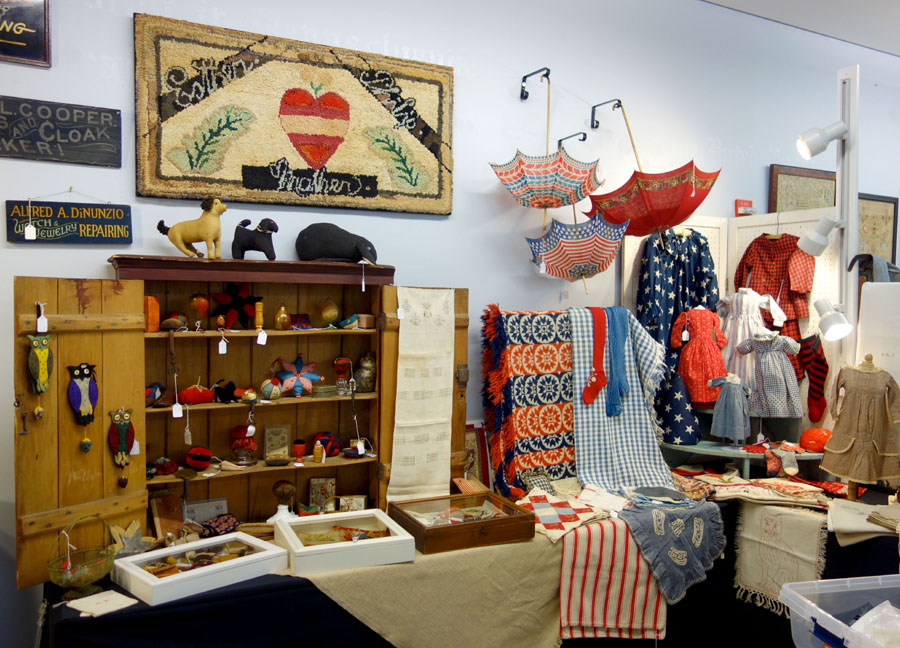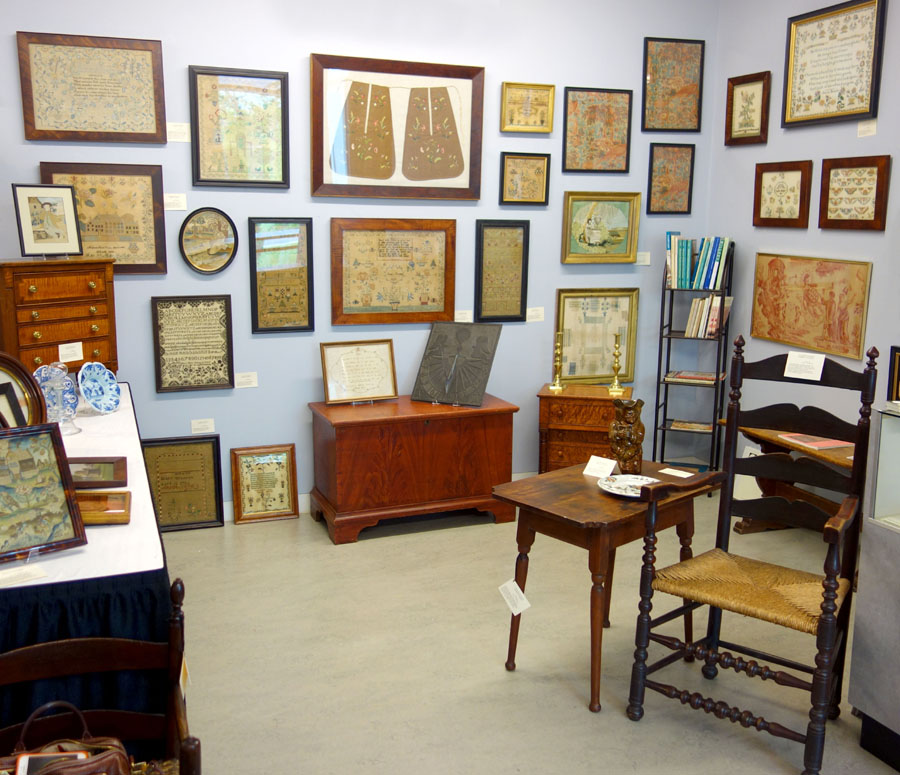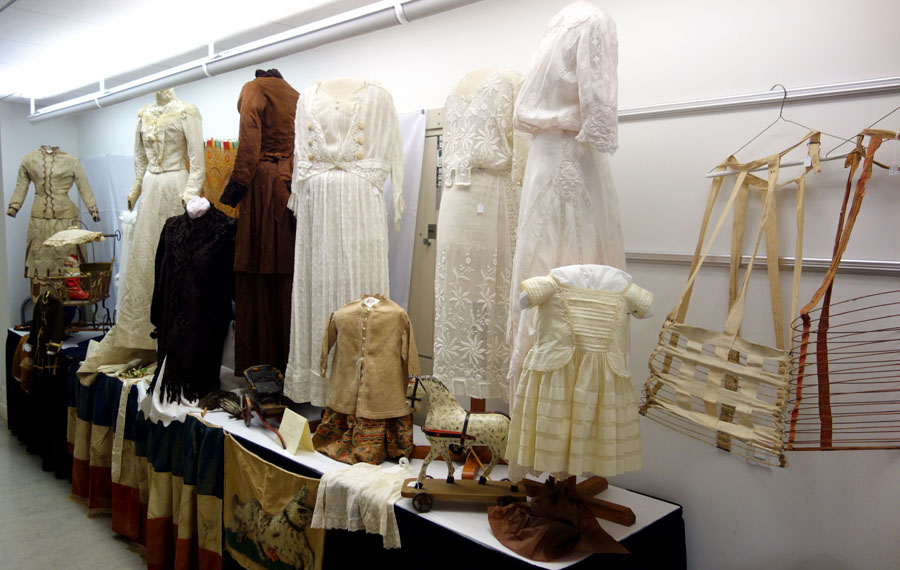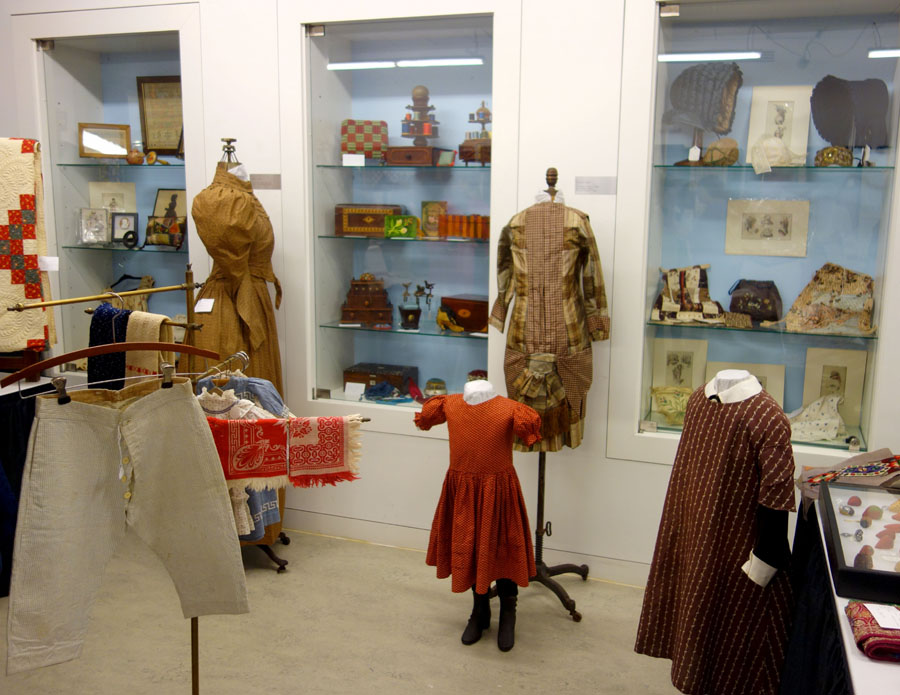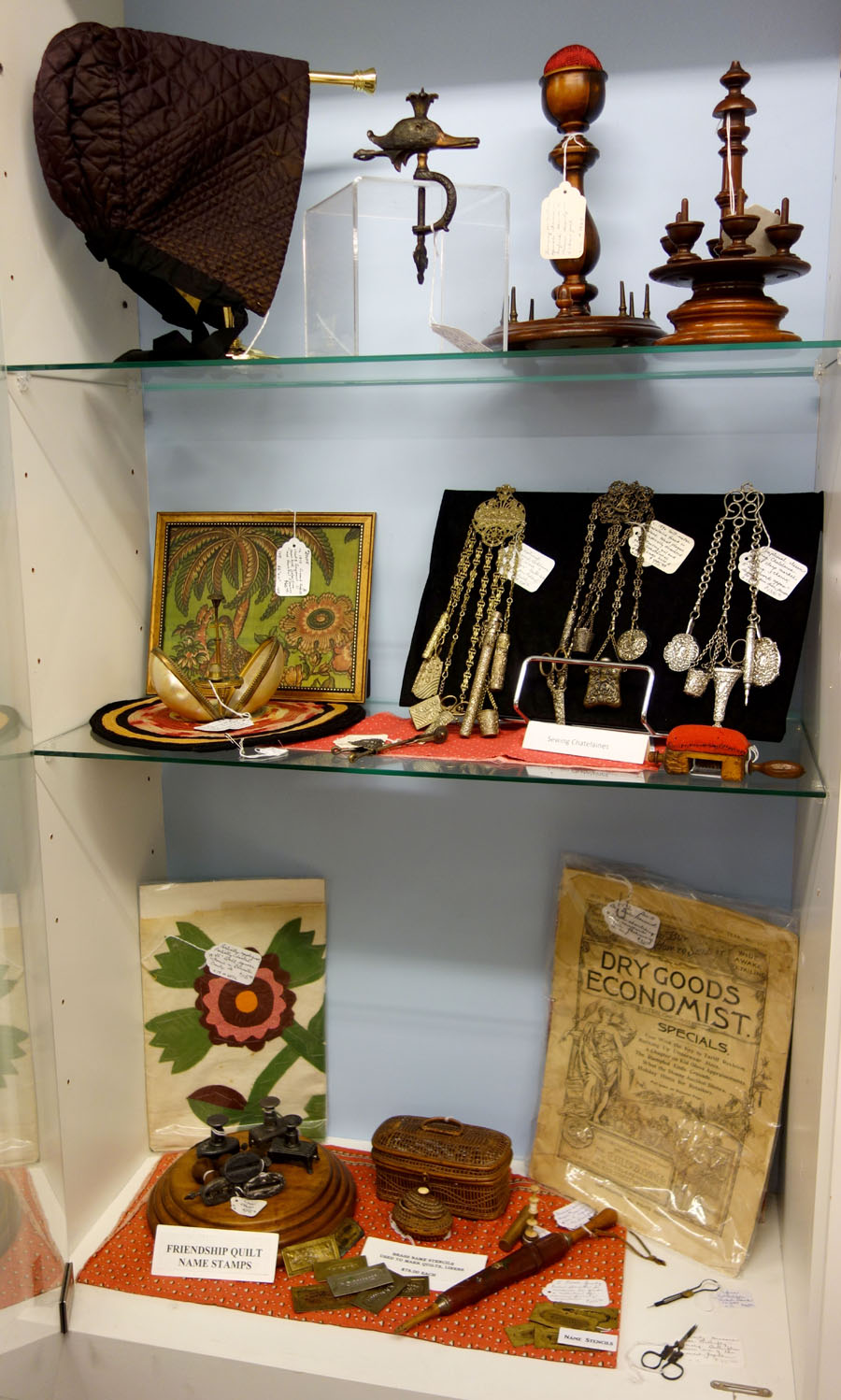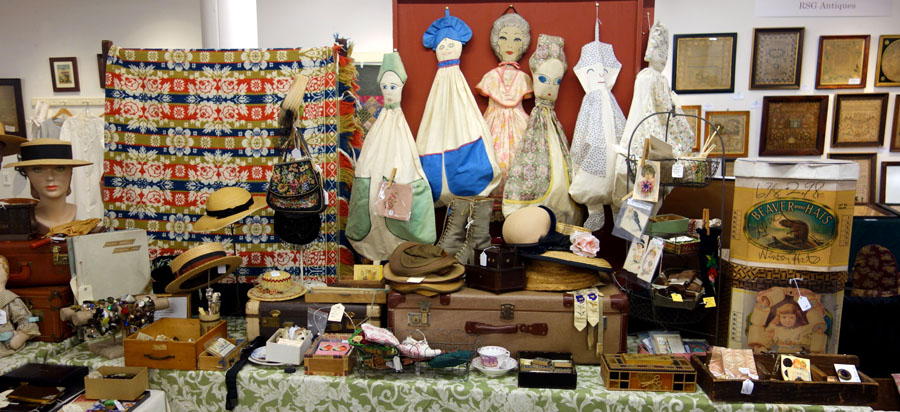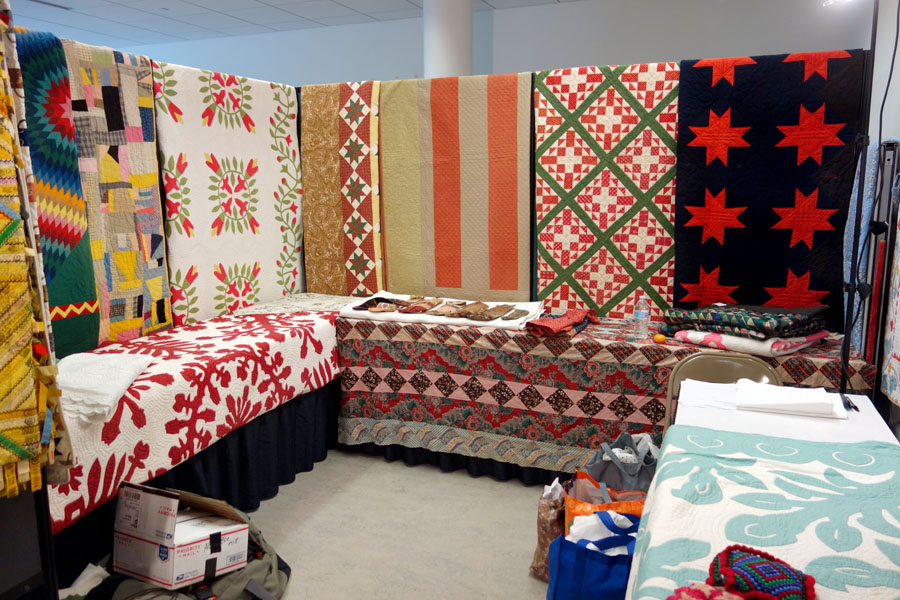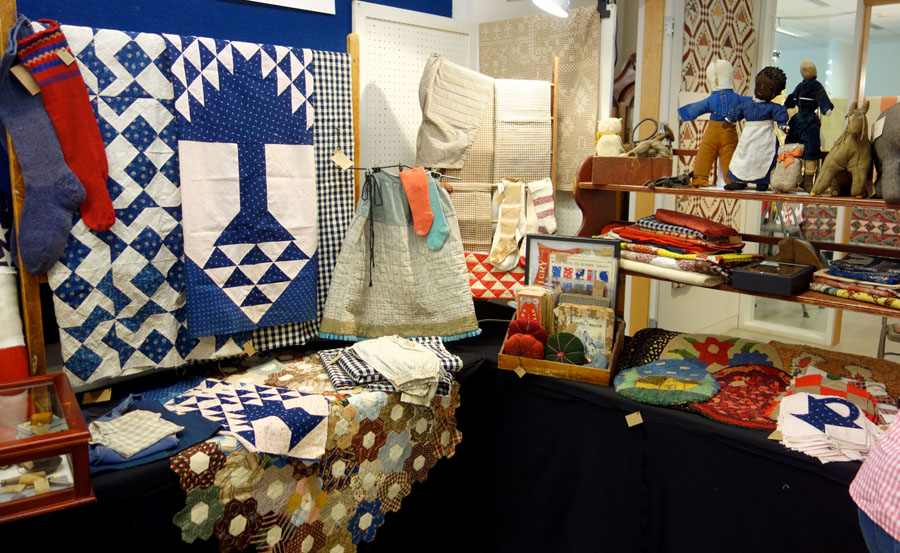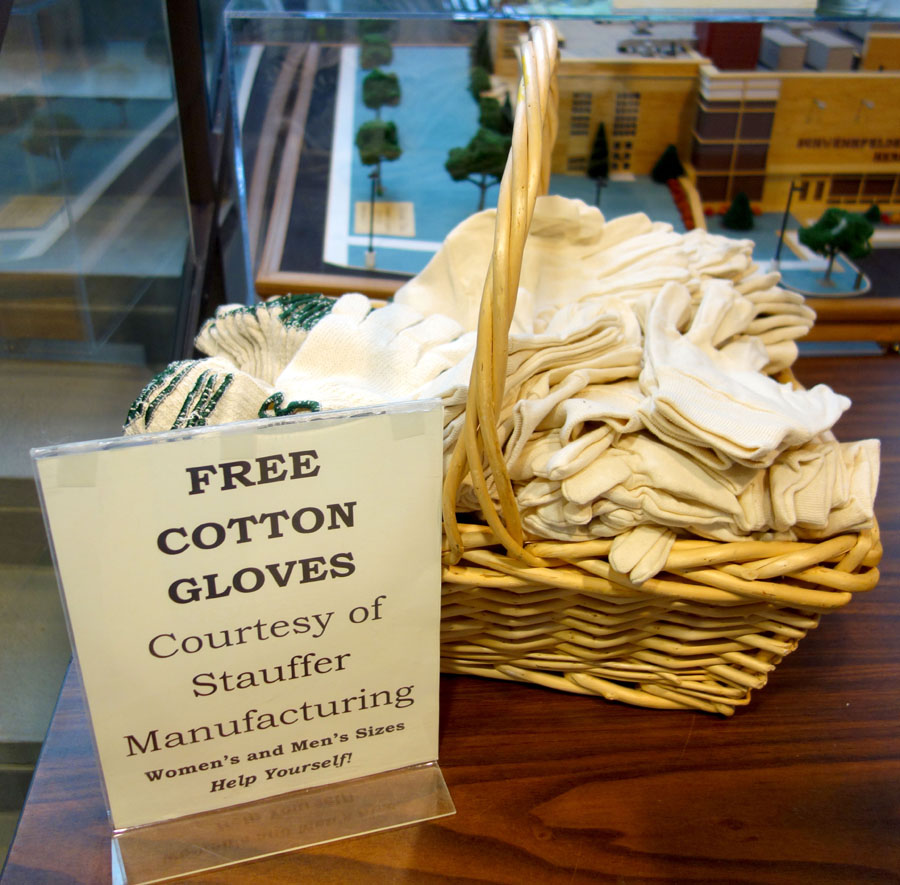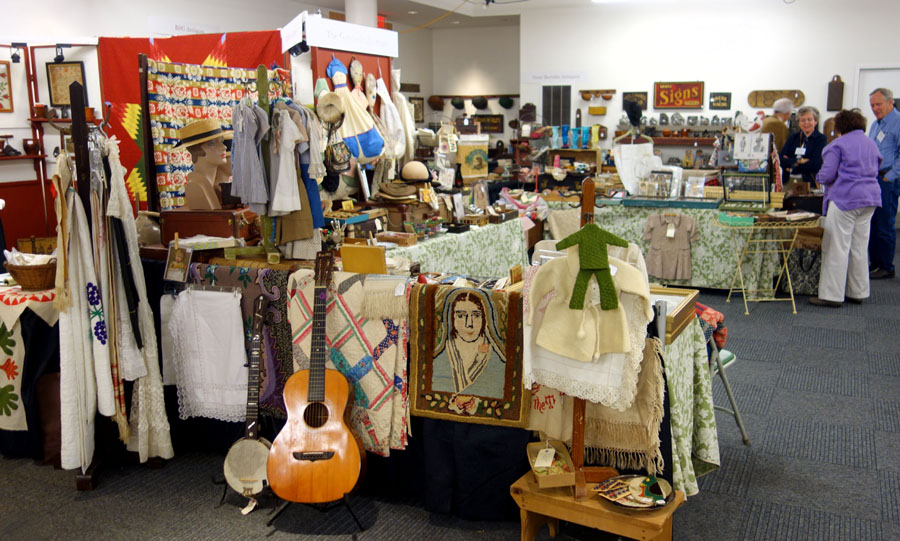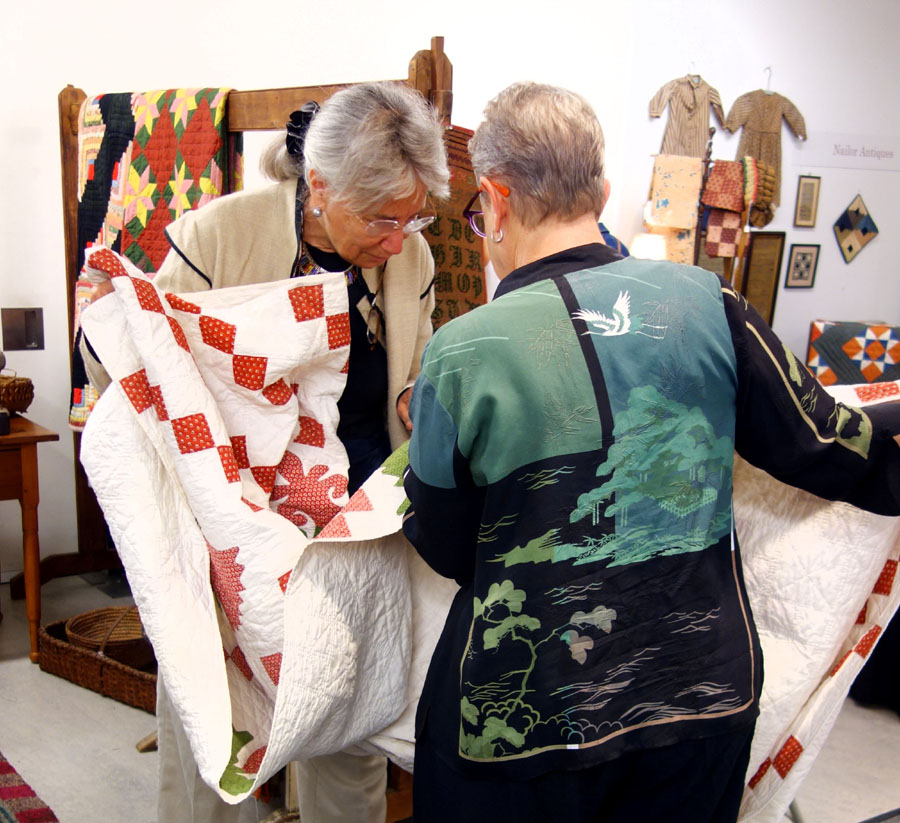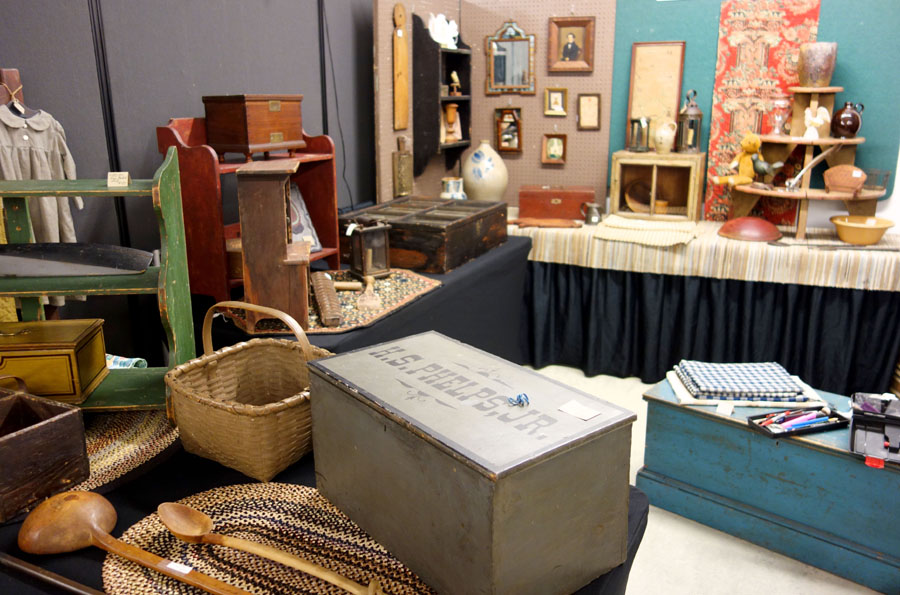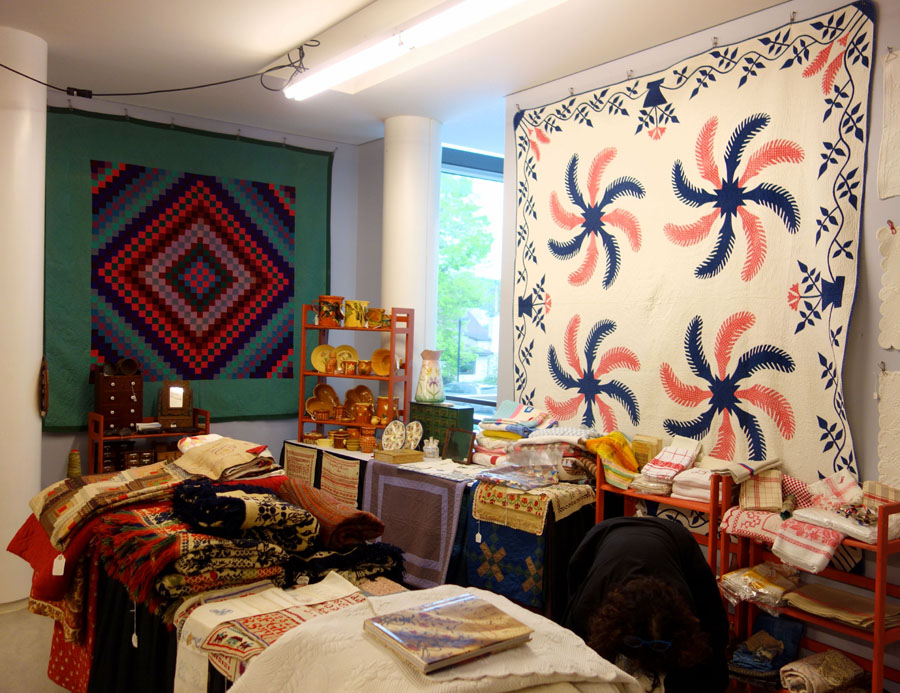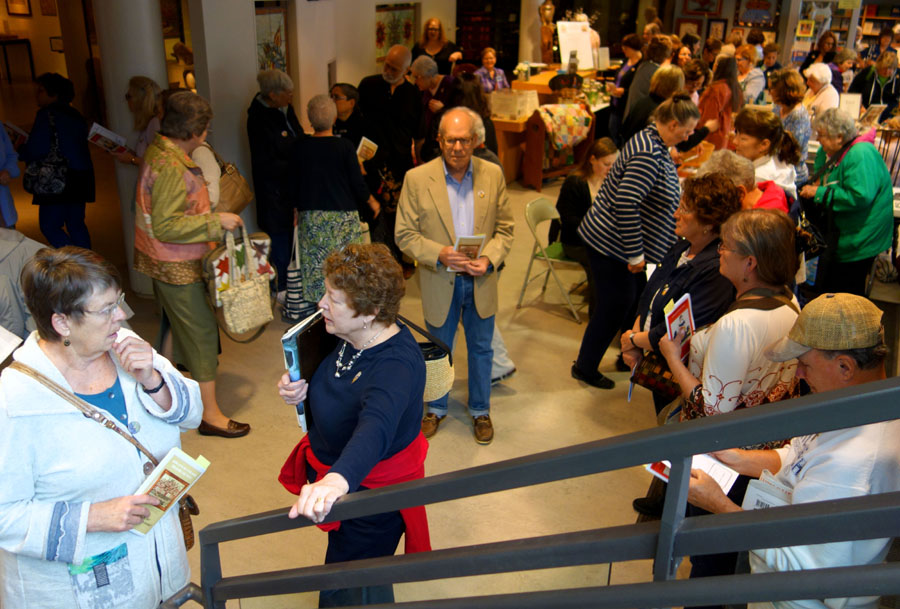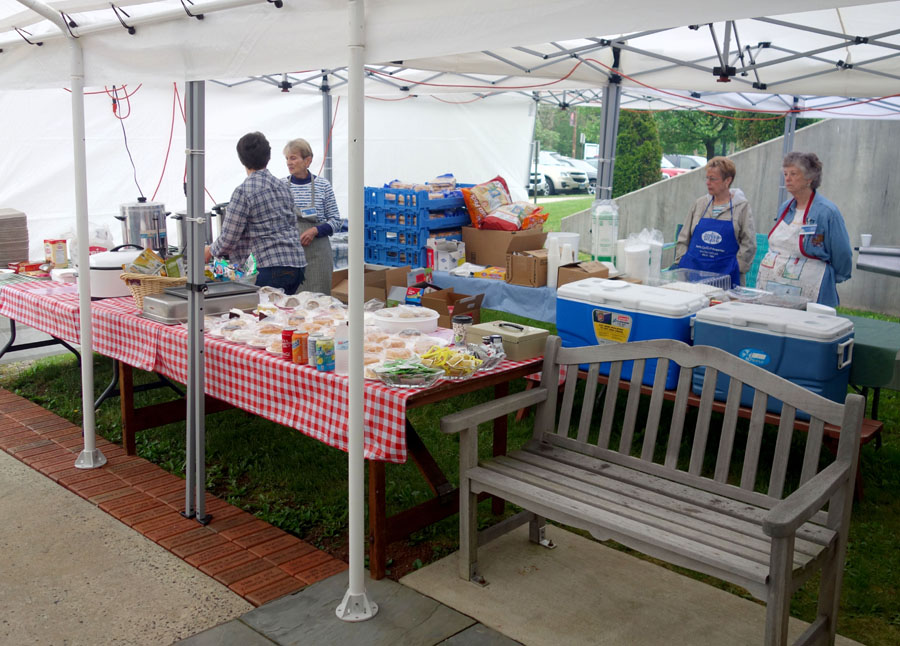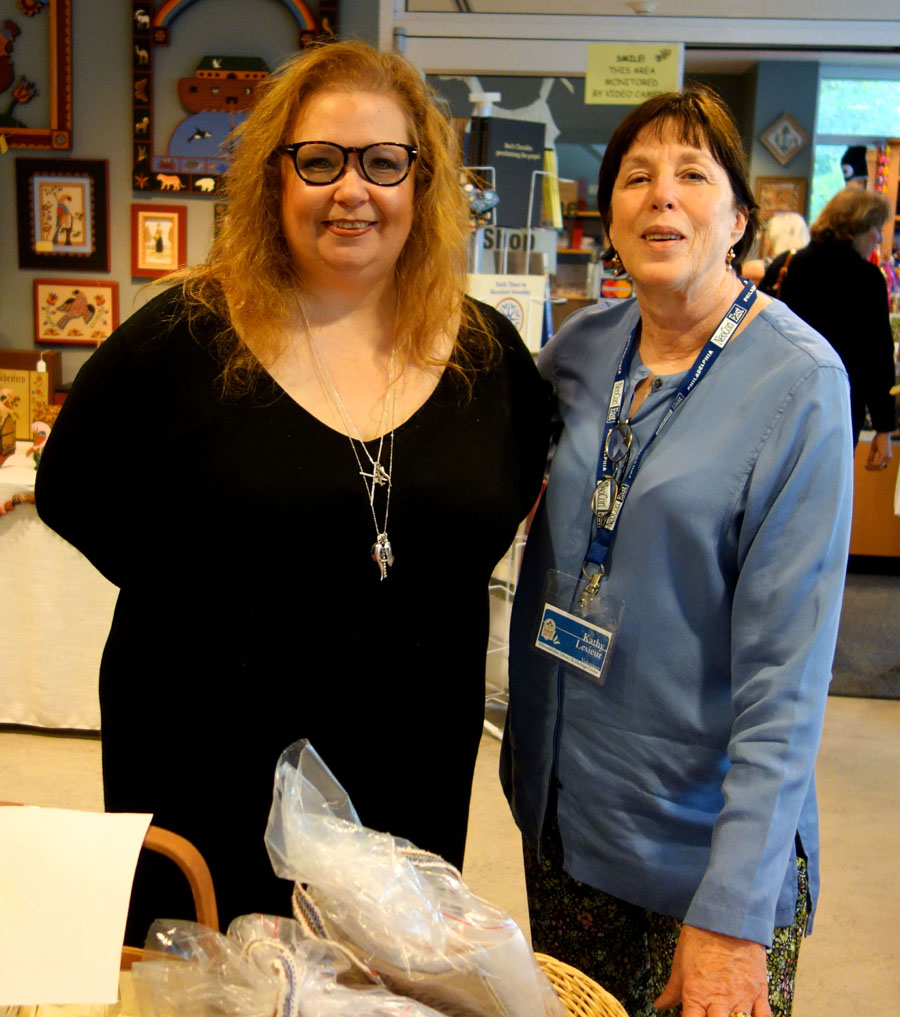
Candace Perry, left, curator of collections, with Kathy Lesieur, a member of the Board of Directors and manager of the Market.
Review and Photos by R. Scudder Smith
PENNSBURG, PENN. — “It all started over four years ago when Candace and I were riding along somewhere and talking about the lecture series sponsored by the Schwenkfelder Library and Heritage Center,” Kathy Lesieur, secretary of the Board of Directors, said. “Once again, the idea of joining the lectures with a dry goods market came into the conversation and it came to pass in 2013,” Kathy added. As time proved, most all of the duties of running the market seemed to basically fall into few hands. Kathy manages the market, which includes both the floor plan and the dealers who fill it. Candace Perry, curator of collections, watches over the busy gift shop on the ground floor, along with ticket sales and lectures. David Luz, executive director, makes sure on market dates that the food tent keeps the tasty servings flowing.
Now there is a formula for success, and The Penn Market seems to have found it. The dealers are filling, some overfilling, their booths with things that meet the wants of visitors, attendance is growing yearly, and management has the luxury of a waiting list of dealers looking forward to doing the market. The market’s location is not only comfortable, but interesting, housed on the second floor of the Schwenkfelder Library & Heritage Center, which is cleared of exhibits and other things to make room for the market. The ground floor is an added attraction displaying a portion of the museum’s collections, a gift shop and special exhibitions. Until September 30, the Fraktur Gallery is showing “Within and Without: The Art of The Book.”
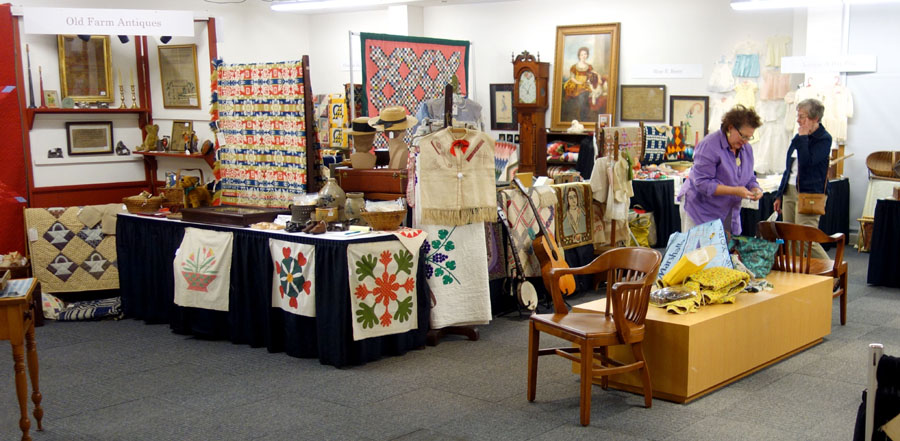
The exhibition area filled with all manner of fabrics, countless spools of thread, sewing boxes and early clothing.
At 10 am on Friday, May 13, following the first of six lectures scheduled for that day, the market opened with guests ascending the stairs in rapid order, while others opted for a slower route via the elevator. Twenty-four exhibitors filled every inch of floor space, presenting a great variety of sewing boxes, clothing for children and adults, many styles of hats, tablecloths and napkins, trade signs, early household necessities such as cookie cutters and rolling pins, samplers and enough spools of thread that, if tied together, might very well circle the earth.
At the foot of the stairway was a basket, filled past the brim, with cotton gloves, courtesy of Stauffer Glove & Safety, a firm located in Red Hill, Penn., since 1955. Prior to that, the company, then known as the Acorn Glove Company, got its start in 1907 in Palm, Penn., by Al and Henry Stauffer. In years past, women often wore cotton gloves when handling fabrics in stores and at the market the tradition carries on.
The booth of John and Peggy Bartley, Old Farm Antiques, Reading Penn., had a number of quilts for sale, including a very colorful star quilt from Mastersonville, Penn., 78 inches square, that lit up a portion of the booth. Among the objects that filled a table to capacity were hat boxes, one complete with a man’s straw hat by Stetson, and a selection of Pennsylvania redware flower pots.
Edna Moran Textile Merchant, Little Silver, N.J., could not have fit another object in her overflowing booth, which was crowded with a 10-foot-high rack holding a wide selection of clothing for little ones, stacks of fabrics and quilts. Spread out at the end of the booth was a quilt of silk and velvet that came from a home in Weehawken, N.J. “I have owned that quilt for about 20 years and this is the first time I have shown it and offered it for sale,” Edna said. She added, “I bought it from the original family and it is really loaded with embroidery.” A sewing box came with a complete history based on an article about it and pictures of the original owners. Tucked away under a table was a large cardboard box she called “men’s things” that was filled with material that would interest men. “While the women are looking over the fabrics, clothing and other things, I just pull a chair up to the box and sit the men down and they have fun plowing through hundreds of things,” Edna said.
David Tuttle of Oley, Penn., offered a variety of objects that ran from a tin colander filled with clothespins of many shapes and forms to a silk on silk embroidered vest, English made and finished over here, circa 1780–1885. A wall shelf, held together with black painted thread spools, was filled with a selection of smalls that included baskets, more clothespins, pen wipes, a gathering of white cotton thread and other collectibles. A tramp art child’s dresser and sewing box were shown with four other sewing boxes, and two quilts were sold within ten minutes of the opening of the show from a stack of about six others.
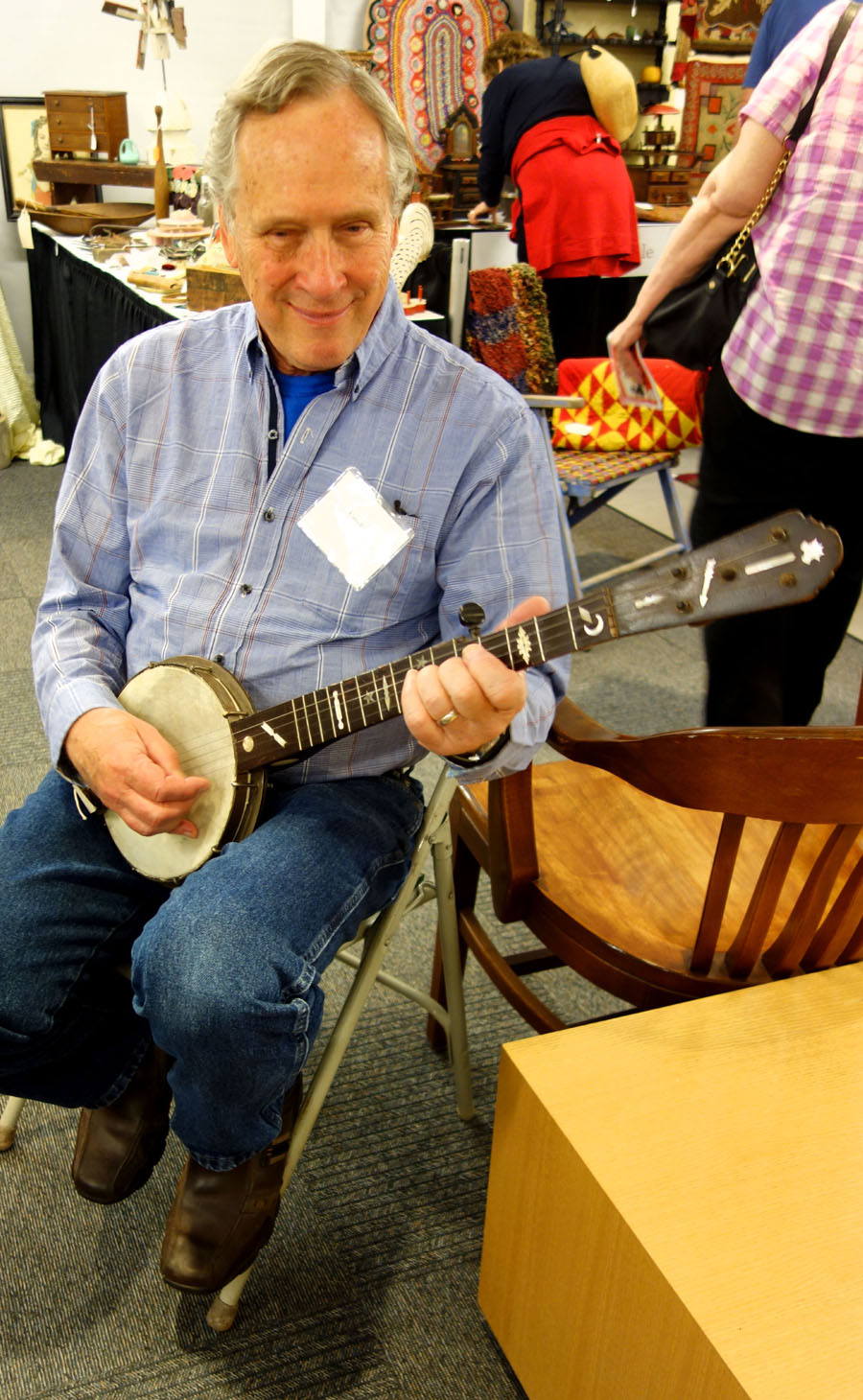
Carroll Swam, operator with Linda Sarubin of The Gatchellville Store in New Park, Penn., came prepared to add some music to the Market.
Antique-A-Day Plus, Nazareth, Penn., offered a pair of carved and painted birds that held both sewing implements and threads, a selection of industrial wooden spools, and four Santa figures dressed in red flannel suits. Randi Ona — Early American Antiques, Wayne, N.J., showed a mounted hooked rug depicting a country home with tree and well in the yard and a dog, flowers and smiling cat along the bottom border. Seven small pot holders, circa Nineteenth Century, New England and Pennsylvania, were individually framed, and a canvas doll with painted face, red dress, sat comfortably in a Nineteenth Century gray painted ladder back child’s chair.
A watercolor of the Westtown Boarding School, probably done by one of the students, was in the booth of Van Tassel-Baumann American Antiques of Malvern, Penn. It depicts a large brick building with four chimneys and flanked by two trees, 7 inches by 8 inches sight, in the original frame and dating circa 1800–30. Among the pieces of furniture offered was a Pennsylvania soft wood blanket chest with red flame rain painted decoration, bracket feet and dating circa 1830. It was of small size and in pristine condition.
If you went to the market in search of early tin cookie cutters, then a stop at the booth of Gene Bertolet Antiques, Oley, Penn., was all you needed. They seemed to be every place you looked and forms included horses, horses with riders, deer, roosters, tall ladies, elephants, chickens and a human hand. A couple of rows of them were shown on one table and a basketful was on another table. Trades signs relating to sewing hung on the wall, four colorful “happy”knock-down figures had seen very little carnival exposure, and four wood-turned flag holders once held Old Glory in a Masonic Lodge.
A painted sewing box, green with yellow and red decoration, dating circa 1860, once belonging to Eve Schaeffer, Penbrook, Penn., was offered by Nailor Antiques of Shiremanstown, Penn. An early blue painted tape loom was on a table of textiles, along with a pair of circa 1860s felt stuffed dogs, one white and one brown.
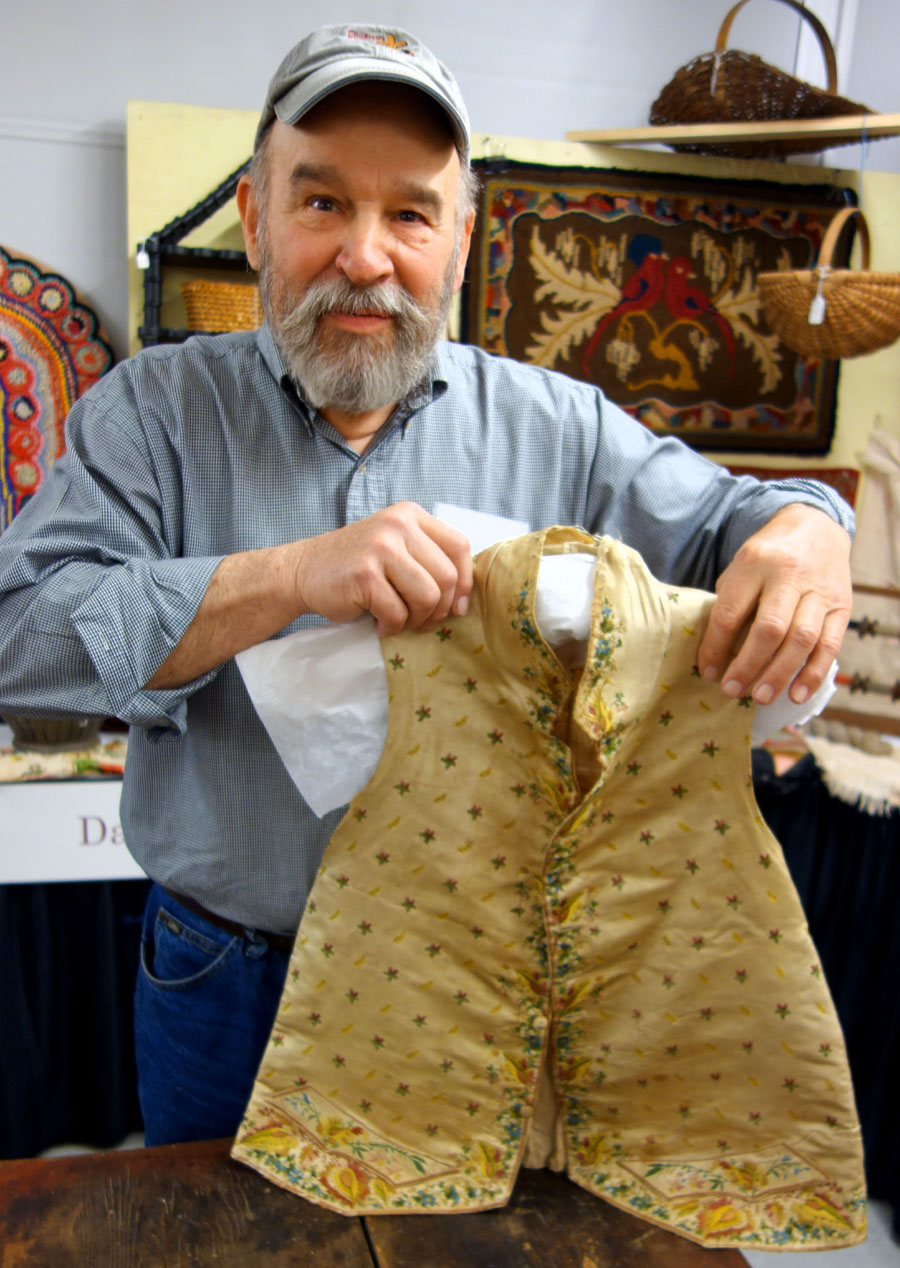
Exhibitor David Tuttle of Oley, Penn., displays one of the rare pieces in the market, a vest that was worked in England and brought to this country to finish, silk embroidered on silk, circa 1780–1790. One person who looked at the piece commented, “It must have been made for a thin man.”
A six-board paneled blanket chest with green painted surface, turned legs, was at the front of the booth of Rose B. Berry, Richmond, Va., and against the back wall was an open cabinet with three shelves holding 16 quilts. Displayed on the top of the cabinet was an oil on canvas of a young lady with spaniel, signed J.A. Vinter, English, 1887 and measuring 43 by 59 inches.
“If you think that our booth is really packed to the brim with stuff, you should see The Gatchellville Store that we operate in New Park, Penn.,” Linda Sarubin said. The store, three stories high, is filled to the brim with a variety of goods, especially buttons, Linda’s real weakness. She has spread her interest in buttons to her four granddaughters and made them collectors. She noted that “when the girls come over to visit, I give them shopping bags and let them loose in the store, and they have a grand time hunting about and building their collections.” In addition to buttons scattered all about the booth, items included a family of six pajama bags and a collection of straw hats, a few displayed on vintage manikins.
Tex Johnson & Son, Adamstown, Penn., showed a collection of eight dresses for tiny tots displayed on a small clothes rack and three elaborate wood-carved sewing boxes, each with a dozen spools of thread. Bonnets for ladies, large and small, were displayed on hat stands, and a roll of Indian Sari edge, silk with real silver, showed its bright colors.
A white whole cloth quilt, 80 inches square, with center medallion of a star and flower pedals, was shown in the booth of Country Things, Bowie, Md. One table was piled high with fabric samples, a bowl held close to a dozen sock darners of different styles, including a few Shaker examples, and spools of thread were in a great variety of colors.
Three show towels hung against the back wall in the booth of Neverbird Antiques, Surry, Va., one with a rare samplerlike alphabet and open work by Mandy Mellar, Lancaster County, Penn., 1839. A sampler executed by Mary Milloy, Sisters of Providence School, Frenchtown, Monroe County, Mich., an African American School, 1851, was stitched with alphabet, birds and a churchlike building.
RSG Antiques, Hanover Township, Penn., captured the attention of visitors with an interest in samplers. Two walls and a portion of the table held a large display, along with other dry goods pieces, including a chip-carved sewing box with crown. Chadds Ford, Penn., exhibitor Ayscough Antiques brought many country things, including several painted boxes, baskets, a pair of painted chalk squirrels, colorful penny rug, three hour glasses of different sizes and a stuffed rabbit with floppy ears with a duck displayed on the top shelf of a whale-end hanging shelf.
The textile history lectures, numbering 11, were an hour each, with a 15-minute break between. On Friday six were presented, covering topics such as “Woolwork Samplers of the Lehigh Valley,” “Old New England Quilts,” “This Work Of Mine The World May View,” and “Over 200 Years of the History of American Embroidery.” On Saturday, three of the five topics were “I shall soon have them done,” “Four Decades of Needlework by Martha Washington,” “Patchwork fever” and “Grace Kelly: Icon of Style.” The same-day registration fee for each lecture is $30.
For those who mark calendars well in advance, shoot for May 19–20 for the next Penn Dry Goods Market. For additional information, http://schwenkfelder.com or 205-679-3103.

